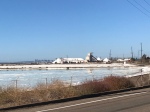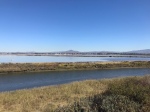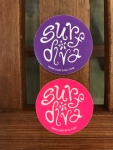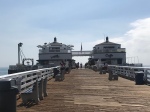San Francisco – Half Moon Bay – Pescadaro – Santa Cruz – Monterey – Carmel – Big Sur – Lucia – Cambia – San Luis Obsipo – Santa Maria – Solvang – Santa Barbara – Carpinteria – Ventura
A long leg (about 750km) taking us south, part-inland where the coast is inaccessible or to avoid busy stretches of highway. As ever, oodles of variety, changing landscapes, drama and quirkiness. It became evident after a few days there would be a definite theme to the inland sections – Fruit & Veg. Vast plains of intensive agriculture looking innocuous on the map – flat profile, dead straight roads, sharp right angle turns – but for hours on end becoming relentless, even tedious. Don’t take this as an indulgent complaint – it’s a fact! And of course there were benefits, some of this produce ended up on our plates. Hurrah for Farm-to-Fork.


To Half Moon Bay. The faithful Komoot took us out of San Fran along an almost level bike lane. Result! Once out of the city conurbation there was a bit of climbing. A coffee stop just when we needed it and chatted with a lady who’d recently cycled coast-to-coast across America, it changed her life. Good on her – she was probably 10+ years ahead of us. Got us thinking about future pedElle-ing.
The route shifted inland and we hit agricultural – field upon field of cabbages, sprouts, strawberries; cabbages, sprouts, strawberries; cabbages, sprouts, strawberries….
And then we crossed in to pumpkin land – acres and acres – in fields, on the side of the road, adorning buildings. When we got to Half Moon Bay the town was awash with them – all shapes, sizes, colours – vegetable, glass, ceramic, velvet, paper…..Then we read, Half Moon Bay is the self-acclaimed pumpkin capital of the world. QED.



To Santa Cruz. We rode much of the day in thick mist. Quite haunting, particularly as we were on some remote roads going through eucalyptus woods, strongly scented in the damp air. But we missed some cool CA surf spots – shrouded in mist. We passed Mavericks at Pillar Point. The Mavs (for those in the know) is on the World surfing circuit and has a Big Wave contest in February when swells generate surf with a 50ft wave face. It would have been incredible to see some of this. Obviously the wrong month for us and in fact it didn’t happen at all this year, locals cite evidence of La Niña pattern.
Our taste of cool was possibly more prosaic but well suited to us. Seeing the best cycling sign thus far (photo below) and Downtown Local cafe in Pescadero – a vintage haven of classic books, vinyl on the turntable, motorcycle gear and B&W films playing on a projector in the back.
Other things that made us smile along the way – a bit of gentle cat-and-mouse with a sky blue vintage convertible driven by a senior ‘cowboy’ in his suede jacket, jeans, Stetson and aviators. Living his dream!….No idea what make but truly beautiful, alas no picture.




To Monterey. An early start, but not until we had breakfasted at a neighboured Brazilian cafe, delicious. And then another day of cabbages, sprouts and for a change, artichokes. We had a glorious ride into Monterey, skirting sand dunes and skittish sand squirrels. The late afternoon sun was catching the oranges, pinks, rusts of succulents growing along the path and the sea was deep blue.
We spent the weekend in Monterey which gave us time to explore, relax, get our hair cut and have the ubiquitous laundromat visit.
We visited the newly opened Cooper-Molera Adobe with buildings dating from 1827 that have survived earthquakes and periods of neglect, been restored and present the layered history of families who lived in and built Monterey from its early years as the political and commercial capital of Mexico’s largest province, to a centre for agricultural/ fishing innovation in CA State. Cooper-Molera was responsible for bringing artichoke farming to the Salinas, by the late 1920s some 12,000 acres were being farmed, and as we‘d seen the day before – still a massive crop.
Fishing has greatly influenced development of the town from the Native Americans, early settlers and through the boom/ bust of whaling and sardine industries. At the turn of the 20th Century Monterey became the centre for canning. The demand for sardines during both world wars lead to periods of growth.Fish was landed and prepared in the shore-side wharves, shuttled across high level bridge links to the canning buildings behind, and back to shore for export. Today, the focus seems to be tourism, Monterey Aquarium and Steinbeck (born in Salinas).

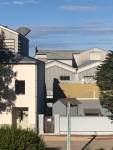
We stumbled across the Porsche Club of America having its annual convention in town. Some beautiful classics (cars, not the drivers) although they looked rather diminutive parked alongside your average American SUV.
On Sunday morning we took the coast road and ‘17 mile drive’ over the headland to Carmel-on-Sea. We left early, and the morning light on the sea was wonderful. The colours were vivid. We were particularly fortunate as part of the route was closed to traffic for the Monterey fun-run, so with some fellow cyclists we had the road to ourselves. The road follows the shoreline, wiggling around coves. It is interspersed with golf courses making some tricky looking but spectacular beachside holes (losing a ball surely doesn’t matter when there’s an outstanding view?). The approach to Carmel took us through pine forests, along private road roads with exclusive housing tucked away and Pebble Beach. Clint Eastwood owns the beach and was Mayor of Carmel in 1986 – get the gist! The town was full of restaurants, Bicyclette had our name all over it but we were too early for lunch; faux pas, poor planning!



Big Sur.This was going to be a highlight. All along our journey people have been telling us what a tremendous route it is, and how lucky we are as the road only fully re-opened mid July, following landslides that washed away great chunks of the highway. Local residents told us it rained solidly for 4 days and more than 1 million tons of roach and dirt fell into the sea burying a quarter mile section of the road and cutting off communities. This followed months of prolonged bad weather and earlier rockslides since January 2017. We saw the rebuilding works where sections of new highway and bridges are still under construction. Impressive, and an engineering challenge coping with the full force of the elements.


We had worked out it was best to ride BS early in the week and to take our time. We spent 2 and a bit days. Our other concern was the weather, which we read can be unpredictable, and a lurking rain cloud hovered over us on the first part of our journey. It arrived on our second day. We had no choice but to ride in the rain – it meant we wore our overshoes (no longer unnecessary luggage). It also meant no-one else was on the road, which was a luxury. In fact the ran wasn’t too bad whilst we were on BS. Later on in the day, however it became hideous – more on this later.
It is hard to put in to words the beauty of this part of the coastline. It is not just about the shoreside, the inland views are just as stunning. The light and reflections are constantly changing; colours are intense – across the spectrum and from a subtle wash to deeply saturated; there is continuous movement – the breeze, surging waves, the kelp, sea life, birds, wafting grasses. in addition the constant changes in elevation mean that one minute you are riding at sea level , the next the land rises and you look down from the road to the sea far below you with accompanying dramatic, plunging bluffs. Nature doing its thing; the results of volcanic activity from below and erosion from above. It was just as beautiful in the rain – different hues and scents, heightened and atmospheric.





Yet again we realise how fortunate we are to be cycling and ‘in’ the landscape, not seeing it truncated as a series of snapshots through a car window. Needless to say we were passed by many open-top cars, probably the next best way to travel!
We found some gems along the way. Lucia, where we stayed in one of a row of wooden cottages that clung to a rocky outcrop. Deetjens Inn at Castro Canyon Creek, a former stopover for travelers along the coastal wagon road before Highway 1 was completed in 1937. In the 1930s the Deetjens constructed a redwood barn using reclaimed materials from Cannery Row in Monterey. Adventurous travelers and artists came for weeks to hike, write, dine and play – the birth of Deetjens Inn. Now a collection of rustic buildings hidden away in lush landscaping, bursting with antiques and character. We stopped here for breakfast and felt we’d walked into a Scott Fitzgerald meets Du Maurier novel. Surrounded by cherubs, quirky pottery, low ceilings, hunting mementos and old photos we ate a huge breakfast serenaded by classical music…..lovely!





To Cambria. This was the rainy day on BS, from Lucia. As time moved on the rain and wind got heavier and heavier. No option but heads down, pedal hard and don’t stop until you arrive! (Editor’s note: Past Hearst Castle – apparently a must see, but not for the very wet and miserable on this day, ditto Harmony with a population of 18 – too bad if you fall pout width your neighbors. Done, we arrived in the midst of Cambria’s annual scarecrow festival. Extraordinary but clearly taken very seriously, full size creations – performing, surfing, chilling, lolling, even cycling – check out the pictures. It helps the town get together and brings in the tourists.
We later learnt our host that evening won best scarecrow in show award in 2017 – for a giant dinosaur! They also won the award for super hosts, in our book. A wonderful B&B – decorated for Fall, with pumpkins, of course. Catering for every wish (offering the laundry when they saw our soggy clothes) and certainly going the extra mile for comfort and hospitality, including an early evening soirée with local wine and delicious appetizers. The following morning breakfast had a Mexican twist and was scrumptious and perfect for a hard day’s ride.




To Santa Maria. What to say – well, slightly intrepid as talking through the next 2 days’ route with our host’s neighbour the night before (also a cyclist) there had been a sharp intake of breathe and ‘that will be a workout’. Joy! Fortunately the rain had passed, early mist cleared and it became a long hot day. We followed the coast, coffee in Morro Bay (more pumpkins as smiley / sad biscuits in the bakery, wondered if the sad ones might end up on the shelf) a detour to San Luis Obispo,recommended for lunch and to get the tyres pumped. On the way into town we passed the Madonna Inn – a noteworthy pop culture landmark and super kitsch with themed rooms, think safari/ caveman/ love nest! Then a long long haul through the veg fields. The afternoon was arduous.



Eventually we came back to the coast. Late afternoon ( and ready to stop) we passed the beautiful Seal Bay and Pismo Bay but with miles still to cycle. We turned inland through yet more veg fields and got to the very busy outskirts of Santa Maria and our home for the night, a dull motel in a retail park on the highway. The grumps set-in big time – why had we opted to stay here and not one of the groovy looking shacks on the coast? (Editor’s note: trip to the supermarket (highlight!) and the gathering of lovely things to make a picnic and a half bottle of fine red wine (gosh how we live!) and things slightly improved!)

To Santa Barbara. The hilly leg of the ‘workout’. Another misty start, more miles of farmland, glasshouses, fruit and veg. Then we turned in to the Foxen Canyon Valley, a wine region. The road was extremely quiet with a gradual incline, the sun was shining, vines were starting to turn and we remembered why we had chosen to stop at Santa Maria. But this was to be the calm before some tough riding later in the day.


En route (actually a voluntary detour) we stopped in Solvang passing more farms, apple and pear orchards this time. Solvang was established by Danish settlers as a cooperative agricultural in 1911. We expected some Scandi-sophistication but were greeted by more of a Disney-esque toy town. (Editor’s note: Claire had drawn a picture of Scandi hues of blues and greens, stripped back wood shacks etc- not this place!) Thankfully we found a haven and had a lazy lunch under the shade of their verandah. Just as well as the afternoon passing through the Santa Ynez Valley was long, hot, hilly and intense with narrow sections of road and some nutty drivers in Friday-get-home-as quick-as-I-can mode. We deliberated at lunch about the route after our waiter said he wouldn’t ride his motorbike on on our chosen route but we placed our faith in Komoot and were super ‘gnarly’ (SoCal lingo – gone beyond radical/ extreme/ perfection/ skill or all combined)! (Editor’s note: Nails in English).

We arrived in Santa Barbara drained and exhausted. We checked in to The Upham Hotel, a period classic that was just perfect for two extremely weary ladies.


We spent the weekend in Santa Barbara. Its historic centre retains the Spanish character brought by early settlers. Replicated when much of the town was rebuilt after a devastating earthquake in 1925, and reinforced by the planners and heritage lobbies of today. It was quite unlike any other town we have visited – red tiled roofs, white stucco, winding passages and intimate courtyards.




Scratching beneath the surface there is clearly tension between those wanting to retain ‘Old Spain in America’ and those who recognise that towns need to evolve (it’s healthy), adapt to changing times/ circumstances and that old and new can co-exist successfully. Strolling through town on Saturday morning we were surprised how quiet it seemed and the number of empty properties, notwithstanding clear affluence and many interesting independents. We discovered the SB Architects Association had organised an ‘open house’ self guided tour of local buildings. How perfect for two planners. But tickets were $80 each – we balked. In London these events are free.
(Skip the next bit if you don’t want planning chat!)
We were further bemused when we discovered the AA event was also promoting results of a public consultation exercise held a few months ago to investigate/ brainstorm ideas to revitalise State Street, the main high street. Why charge 80 bucks – it seems one easy way to alienate and disenfranchise people.
In brief, State Street is a long road, the spine of the old town, which ends at the beach but here becomes a dual carriageway as it goes under the freeway and over the railway. Instantly an unwelcome environment for anyone wanting to walk or cycle from the town centre to the beach although a hop on/ off shuttle bus goes up and down the street and along the beachfront, which is positive. The newly established Funk Zone is a draw at this end of town, former warehouses and industrial buildings being converted into studios, workshops, cafes, restaurants. Another example where some imagination and entrepreneurial spirit is injecting new life.
In response to local concerns about rising vacancies in the town centre and increasing homelessness, the AA held a charette and invited local architects and interested parties to come up with ideas at three levels – for State Street as the main drag, at street block scale and at individual plot scale. Reading some of the press commentary at the time, there appear to be the often cited criticism of landlords/ developers/ politicians/ planners – and claims of too much intervention, rigour, fastidiousness, inconsistency, greed, delay. The draw of Funk Zone gets criticism – surely its energy should be harnessed and seen as an asset. It is a rather depressing catalogue of complaints and blame. Whilst researching I came across one shocking quote that the homeless should be ‘moved on’ implying out-of-site, out-of-mind.
Suggestions coming out of the charette seemed (to us) pretty obvious – more and higher density housing in the centre (all tenures), mixed use on upper floors, densify sensitively, encourage contextual contemporary design, improve linkages, walking and cycling, reduce car parking etc etc. But will anything be done? It needs a joined up town centre strategy cutting through the silos of beurocracy – call in the Ross!
Other snippets from SB – movies were being made in the town long before LA’s claim to fame; silent films and Charlie Chaplin was a regular visitor. We had a wonderful yoga class at DiviniTree. There are some beautiful gardens. And, of course we ate well! (Editor’s note. The highlight being Smithy’s, which served us pretty ie attractive small plates of Southern Californian food).



To Ventura. This was a gentle Sunday ride along the coast through ‘seaside’ villages in the sunshine. In Carpinteria we cycled passed the California Avocado Festival aka Avofest (yes, more veg). Avos in every conceivable guise, live music, folk, dogs and fiesta time. We got to Ventura mid afternoon and our trailer at Waypoint, a renovated 1950s Airstream from Arizona with our own patch of carpet grass, deck and fairy lights. Having spent weeks sharing the road with trailers we felt it was time to get on board. Inside it was super snug and reminded me of childhood days in The Van, our family dormobile, Zzzzz.








